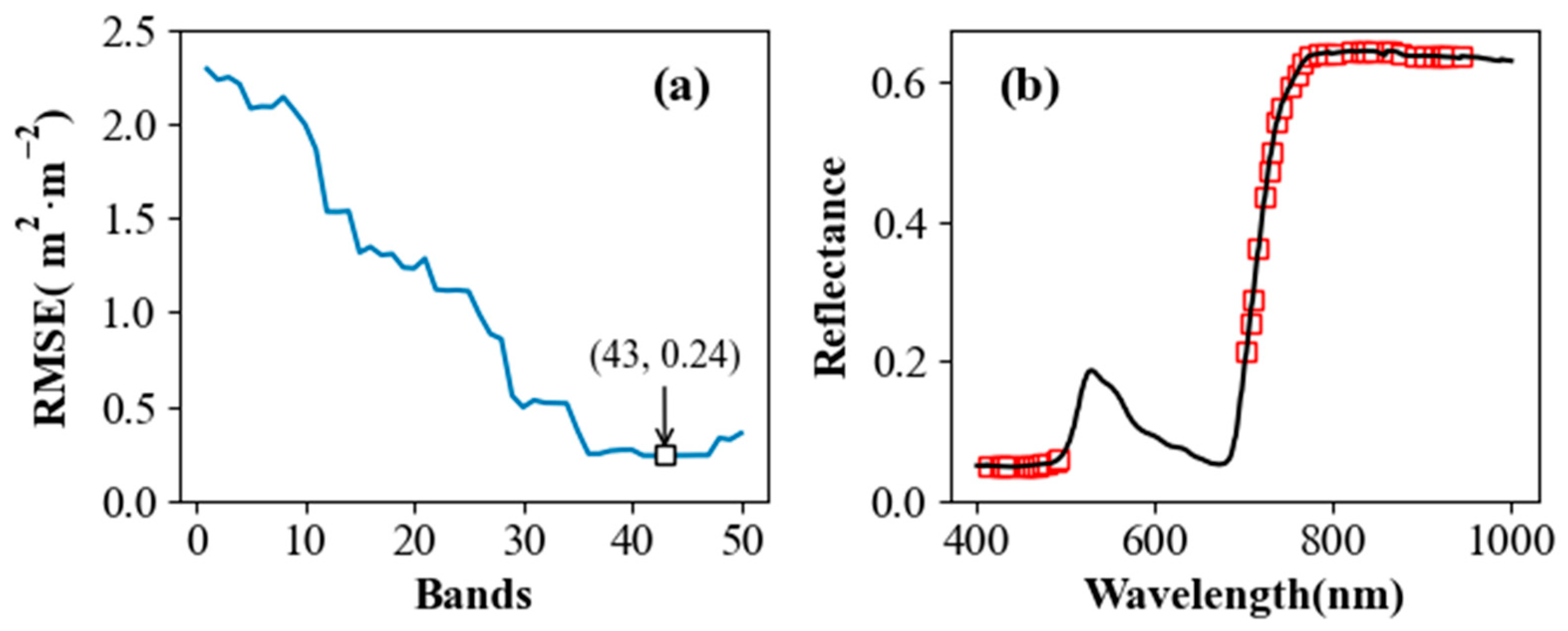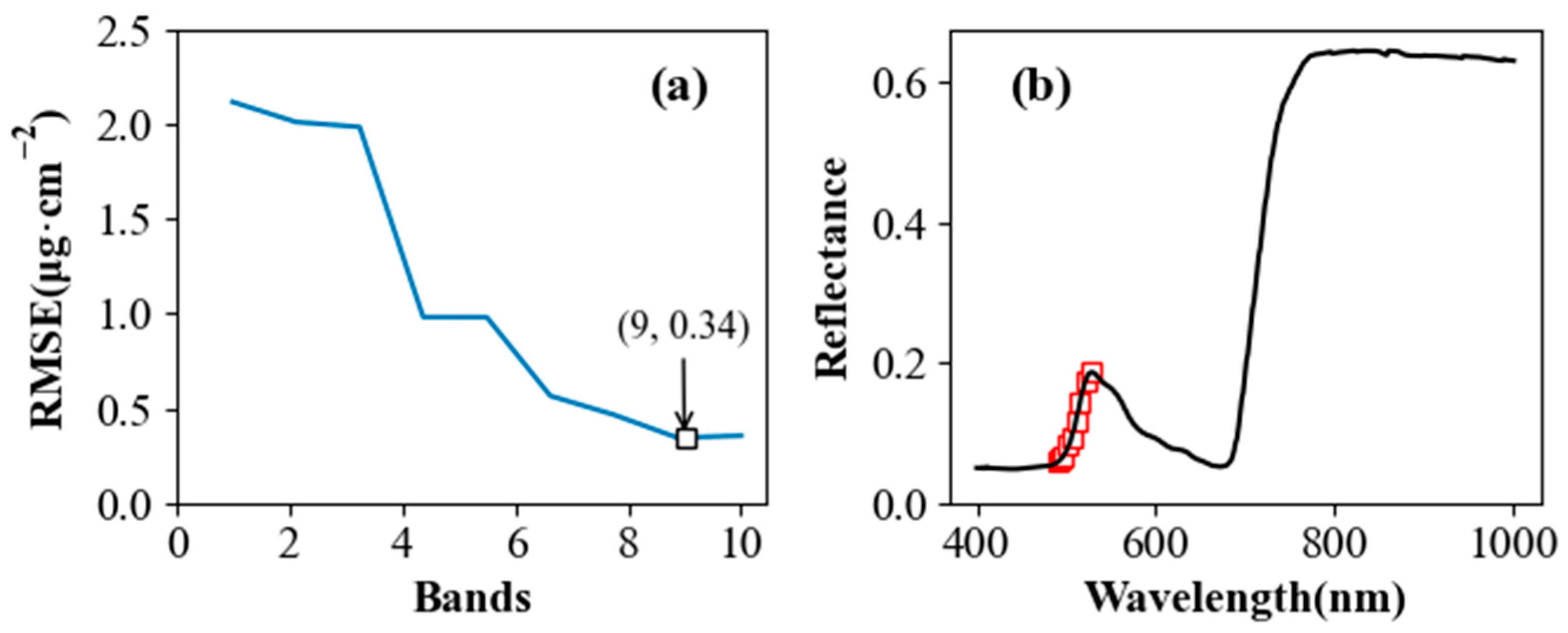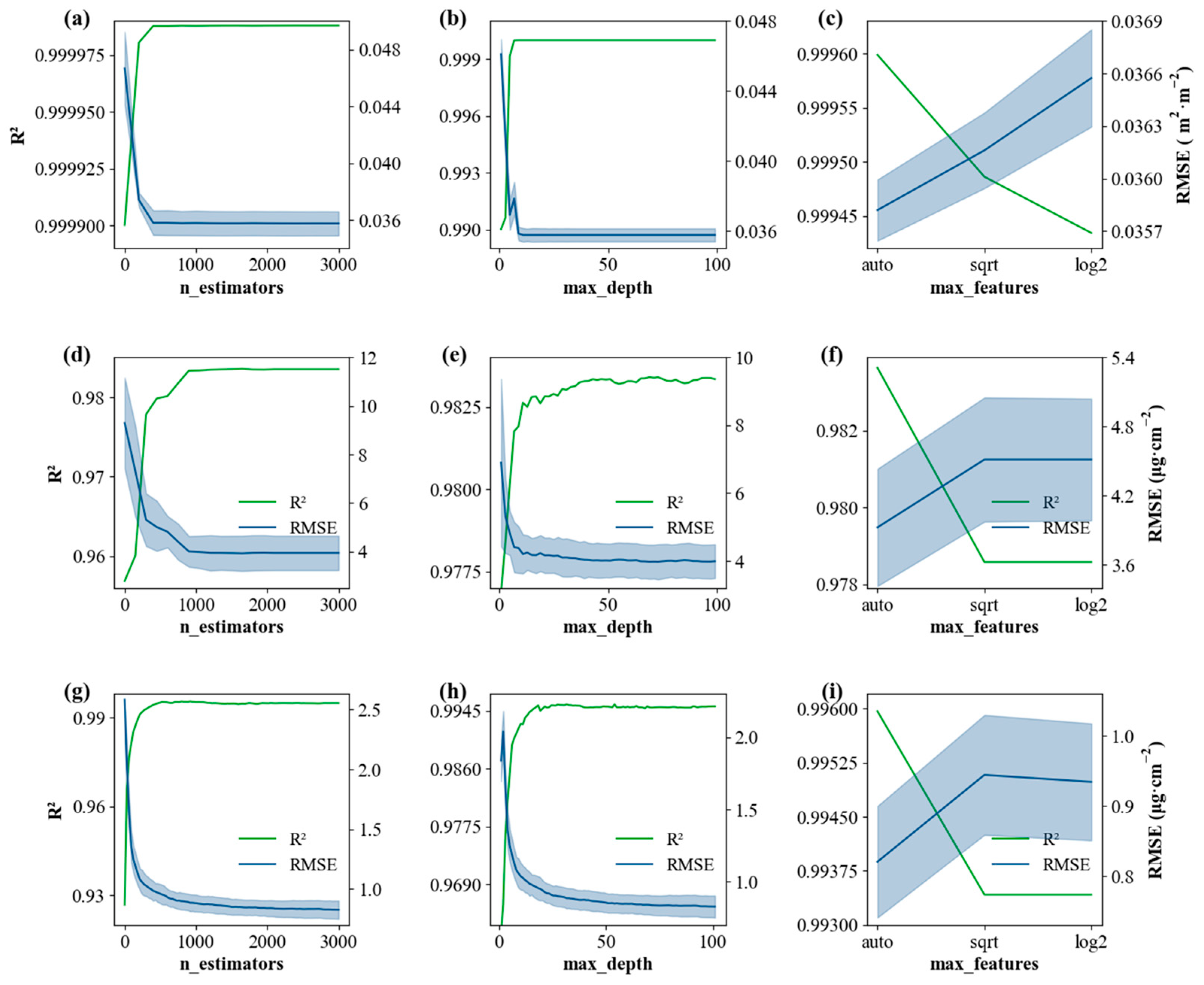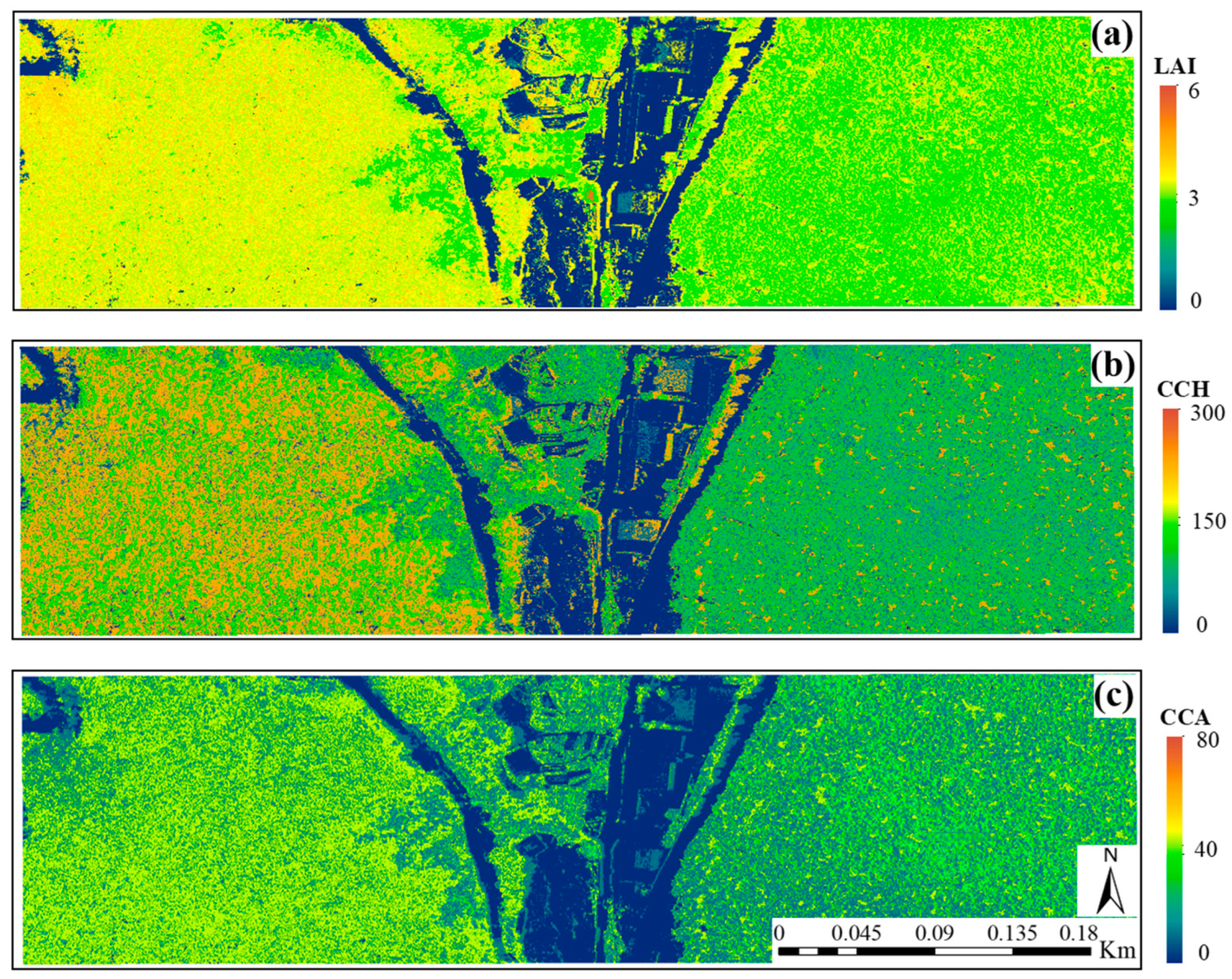Coupling the PROSAIL Model and Machine Learning Approach for Canopy Parameter Estimation of Moso Bamboo Forests from UAV Hyperspectral Data
Abstract
:1. Introduction
2. Materials and Methods
2.1. Experimental Site
2.2. Data Collection and Organization
2.2.1. Sample Plot Data Collection and Measurement
2.2.2. Remote Sensing Data Collection and Preprocessing
2.3. Research Methodology
2.3.1. Introduction to the PROSAIL Model
2.3.2. Global Sensitivity Analysis Based on the EFAST Parameters
2.3.3. Characterization Band Selection
2.3.4. Introduction to Machine Learning Models
- MLPR
- ETR
- XGBR
2.3.5. PROSAIL_MLRA Model Construction
3. Results
3.1. Sensitivity of Canopy Reflectance Spectra to PROSAIL Model Input Parameters
3.2. Selection of the Bands for the Characterization of the Moso Bamboo Canopy Parameters
3.3. Comparison of the Inversion Models for the Canopy Parameters of the MBF
3.3.1. Inversion of the Canopy Parameters Based on MLPR
3.3.2. ETR-Based Inversion of the Canopy Parameters
3.3.3. XGBR-Based Inversion of the Canopy Parameters
3.3.4. Comparison of Model Result
4. Discussion
4.1. Impact of Parametric Sensitivity Analysis on PROSAIL Modeling
4.2. Influence of Spatial Resolution of UAV Images on Canopy Parameter Inversion
4.3. Mixed Inversion Modeling of Canopy Parameters
5. Conclusions
Author Contributions
Funding
Data Availability Statement
Conflicts of Interest
Abbreviations
| LAI | Leaf area index |
| CCH | Canopy chlorophyll content |
| CCA | Canopy carotenoid content |
| UAV | Unmanned aerial vehicles |
| MBF | Moso bamboo forest |
| MLRA | Machine learning regression algorithm |
| EFAST | Extended Fourier amplitude sensitivity test |
| MLPR | Multilayer perceptron regressor |
| ETR | Extra tree regressor |
| XGBR | Extreme gradient boosting regressor |
| SPA | Successive projections algorithm |
| CAB | Chlorophyll content |
| CAR | Carotenoid content |
| Si | Sensitivity index |
| STi | Sensitivity index |
| GridSearchCV | Grid search algorithm |
References
- Croft, H.; Chen, J.M.; Wang, R.; Mo, G.; Luo, S.; Luo, X.; He, L.; Gonsamo, A.; Arabian, J.; Zhang, Y.; et al. The global distribution of leaf chlorophyll content. Remote Sens. Environ. 2020, 236, 111–479. [Google Scholar] [CrossRef]
- Skidmore, A.K.; Coops, N.C.; Neinavaz, E.; Ali, A.; Schaepman, M.E.; Paganini, M.; Kissling, W.D.; Vihervaara, P.; Darvishzadeh, R.; Feilhauer, H.; et al. Priority list of biodiversity metrics to observe from space. Nat. Ecol. Evol. 2021, 5, 896–906. [Google Scholar] [CrossRef] [PubMed]
- Du, H.; Zhou, G.; Mao, F.; Han, L. Quantitative Inversion of Bamboo Forest Parameters by Multi-Source Remote Sensing; Science Press: Beijing, China, 2022; p. 142. [Google Scholar]
- Sun, J.; Wang, L.; Shi, S.; Li, Z.; Yang, J.; Gong, W.; Wang, S.; Tagesson, T. Leaf pigment retrieval using the PROSAIL model: Influence of uncertainty in prior canopy-structure information. Crop J. 2022, 10, 1251–1263. [Google Scholar] [CrossRef]
- Fang, H.; Baret, F.; Plummer, S.; Schaepman, G. An Overview of Global Leaf Area Index (LAI): Methods, Products, Validation, and Applications. Rev. Geophys. 2020, 57, 739–799. [Google Scholar] [CrossRef]
- Wu, G.; Jiang, C.; Kimm, H.; Wang, S.; Bernacchi, C.; Moore, C.E.; Suyker, A.; Yang, X.; Magney, T.; Frankenberg, C.; et al. Difference in seasonal peak timing of soybean far-red SIF and GPP explained by canopy structure and chlorophyll content. Remote Sens. Environ. 2022, 279, 113104. [Google Scholar] [CrossRef]
- Zhang, L.; Gao, H.; Zhang, X. Combining Radiative Transfer Model and Regression Algorithms for Estimating Aboveground Biomass of Grassland in West Ujimqin, China. Remote Sens. 2023, 15, 2918. [Google Scholar] [CrossRef]
- Gara, T.W.; Darvishzadeh, R.; Skidmore, A.K.; Wang, T.; Heurich, M. Accurate modelling of canopy traits from seasonal Sentinel-2 imagery based on the vertical distribution of leaf traits. ISPRS J. Photogramm. Remote Sens. 2019, 157, 108–123. [Google Scholar] [CrossRef]
- Ji, J.; Li, X.; Du, H.; Mao, F.; Fan, W.; Xu, Y.; Huang, Z.; Wang, J.; Kang, F. Multiscale leaf area index assimilation for Moso bamboo forest based on Sentinel-2 and MODIS data. Int. J. Appl. Earth Obs. Geoinf. 2021, 104, 102519. [Google Scholar] [CrossRef]
- Zhu, J.; Yin, Y.; Lu, J.; Warner, T.A.; Xu, X.; Lyu, M.; Wang, X.; Guo, C.; Cheng, T.; Zhu, Y.; et al. The relationship between wheat yield and sun-induced chlorophyll fluorescence from continuous measurements over the growing season. Remote Sens. Environ. 2023, 298, 113791. [Google Scholar] [CrossRef]
- Liang, S. Quantitative Remote Sensing of Land Surfaces; John Wiley & Sons: Hoboken, NJ, USA, 2003; pp. 1–534. [Google Scholar] [CrossRef]
- Kang, F.; Li, X.; Du, H.; Mao, F.; Zhou, G.; Xu, Y.; Huang, Z.; Ji, J.; Wang, J. Spatiotemporal Evolution of the Carbon Fluxes from Bamboo Forests and their Response to Climate Change Based on a BEPS Model in China. Remote Sens. 2022, 14, 366. [Google Scholar] [CrossRef]
- Yu, K.; Lenz-Wiedemann, V.; Chen, X.P.; Bareth, G. Estimating leaf chlorophyll of barley at different growth stages using spectral indices to reduce soil background and canopy structure effects. Isprs J. Photogramm. Remote Sens. 2014, 97, 58–77. [Google Scholar] [CrossRef]
- Asner, G.P.; Mascaro, J.; Anderson, C.; Knapp, D.E.; Martin, R.E.; Kennedy-Bowdoin, T.; van Breugel, M.; Davies, S.; Hall, J.S.; Muller-Landau, H.C.; et al. High-fidelity national carbon mapping for resource management and REDD+. Carbon Balance Manag. 2015, 8, 7. [Google Scholar] [CrossRef] [PubMed]
- Zhang, Y.; Migliavacca, M.; Penuelas, J.; Ju, W. Advances in hyperspectral remote sensing of vegetation traits and functions. Remote Sens. Environ. 2021, 252, 112121. [Google Scholar] [CrossRef]
- Guo, K.; Li, X.; Du, H.; Mao, F.; Ni, C.; Chen, Q.; Xu, Y.; Huang, Z. Wavelet Vegetation Index to Improve the Inversion Accuracy of Leaf V25cmax of Bamboo Forests. Remote Sens. 2023, 15, 2362. [Google Scholar] [CrossRef]
- Chen, Z.; Jia, K.; Xiao, C.; Wei, D.; Zhao, X.; Lan, J.; Wei, X.; Yao, Y.; Wang, B.; Sun, Y.; et al. Leaf Area Index Estimation Algorithm for GF-5 Hyperspectral Data Based on Different Feature Selection and Machine Learning Methods. Remote Sens. 2020, 12, 2110. [Google Scholar] [CrossRef]
- Li, Y.; Liang, S. Evaluation of Reflectance and Canopy Scattering Coefficient Based Vegetation Indices to Reduce the Impacts of Canopy Structure and Soil in Estimating Leaf and Canopy Chlorophyll Contents. IEEE Trans. Geosci. Remote Sens. 2023, 61, 4403015. [Google Scholar] [CrossRef]
- Houborg, R.; Fisher, J.B.; Skidmore, A.K. Advances in remote sensing of vegetation function and traits. Int. J. Appl. Earth Obs. Geoinf. 2015, 43, 1–6. [Google Scholar] [CrossRef]
- He, L.; Ren, X.; Wang, Y.; Liu, B.; Zhang, H.; Liu, W.; Feng, W.; Guo, T. Comparing methods for estimating leaf area index by multi-angular remote sensing in winter wheat. Sci. Rep. 2020, 10, 13943. [Google Scholar] [CrossRef] [PubMed]
- Li, H.; Fan, W.; Yu, Y.; Yang, Y. Leaf area index retrieval based on prospect, liberty and geosail models. Sci. Silvae Sin. 2011, 47, 75–81. [Google Scholar] [CrossRef]
- Duan, S.-B.; Li, Z.-L.; Wu, H.; Tang, B.-H.; Ma, L.; Zhao, E.; Li, C. Inversion of the PROSAIL model to estimate leaf area index of maize, potato, and sunflower fields from unmanned aerial vehicle hyperspectral data. Int. J. Appl. Earth Obs. Geoinf. 2014, 26, 12–20. [Google Scholar] [CrossRef]
- Gupta, S.K.; Pandey, A.C. PROSAIL and empirical model to evaluate spatio-temporal heterogeneity of canopy chlorophyll content in subtropical forest. Model. Earth Syst. Environ. 2022, 8, 2151–2165. [Google Scholar] [CrossRef]
- Xiao, Y.; Zhao, W.; Zhou, D.; Gong, H. Sensitivity of canopy reflectance to biochemical and biophysical variables. J. Remote Sens. 2015, 19, 368–374. [Google Scholar] [CrossRef]
- Ma, J.; Huang, S.; Li, J.; Xi, L. Global sensitivity analysis of parameters in the PROSAIL model based on modified sobol’s method. Bull. Surv. Mapp. 2016, 3, 33–35. [Google Scholar] [CrossRef]
- Binh, N.A.; Hauser, L.T.; Viet Hoa, P.; Thi Phuong Thao, G.; An, N.N.; Nhut, H.S.; Phuong, T.A.; Verrelst, J. Quantifying mangrove leaf area index from Sentinel-2 imagery using hybrid models and active learning. Int. J. Remote Sens. 2022, 43, 5636–5657. [Google Scholar] [CrossRef] [PubMed]
- Shorten, P.R.; Leath, S.R.; Schmidt, J.; Ghamkhar, K. Predicting the quality of ryegrass using hyperspectral imaging. Plant Methods 2019, 15, 63. [Google Scholar] [CrossRef] [PubMed]
- Canova, L.d.S.; Vallese, F.D.; Pistonesi, M.F.; de Araújo Gomes, A. An improved successive projections algorithm version to variable selection in multiple linear regression. Anal. Chim. Acta 2023, 1274, 341560. [Google Scholar] [CrossRef] [PubMed]
- Lu, D.; Chen, Q.; Wang, G.; Liu, L.; Li, G.; Moran, E. A survey of remote sensing-based aboveground biomass estimation methods in forest ecosystems. Int. J. Digit. Earth 2014, 9, 63–105. [Google Scholar] [CrossRef]
- Meng, S.; Pang, Y.; Zhang, Z.; Jia, W. Mapping Aboveground Biomass using Texture Indices from Aerial Photos in a Temperate Forest of Northeastern China. Remote Sens. 2016, 8, 230. [Google Scholar] [CrossRef]
- Chen, L.; Ren, C.; Zhang, B.; Wang, Z. Estimation of forest above-ground biomass by geographically weighted regression and machine learning with sentinel imagery. Forest 2018, 9, 582. [Google Scholar] [CrossRef]
- De Sá, N.C.; Baratchi, M.; Hauser, L.T.; van Bodegom, P. Exploring the Impact of Noise on Hybrid Inversion of PROSAIL RTM on Sentinel-2 Data. Remote Sens. 2021, 13, 648. [Google Scholar] [CrossRef]
- Jiao, Q.; Sun, Q.; Zhang, B.; Huang, W.; Ye, H.; Zhang, Z.; Zhang, X.; Qian, B. A Random Forest Algorithm for Retrieving Canopy Chlorophyll Content of Wheat and Soybean Trained with PROSAIL Simulations Using Adjusted Average Leaf Angle. Remote Sens. 2022, 14, 98. [Google Scholar] [CrossRef]
- Liang, L.; Di, L.; Zhang, L.; Deng, M.; Qin, Z.; Zhao, S.; Lin, H. Estimation of crop LAI using hyperspectral vegetation indices and a hybrid inversion method. Remote Sens. Environ. 2015, 165, 123–134. [Google Scholar] [CrossRef]
- Verrelst, J.; Camps-Valls, G.; Muñoz-Marí, J.; Rivera, J.P.; Veroustraete, F.; Clevers, J.G.P.W.; Moreno, J. Optical remote sensing and the retrieval of terrestrial vegetation bio-geophysical properties—A review. ISPRS J. Photogramm. Remote Sens. 2015, 108, 273–290. [Google Scholar] [CrossRef]
- Dong, T.; Liu, J.; Qian, B.; Zhao, T. Estimating winter wheat biomass by assimilating leaf area index derived from fusion of Landsat-8 and MODIS data. Int. J. Appl. Earth Obs. Geoinf. 2016, 49, 63–74. [Google Scholar] [CrossRef]
- Pham, L.T.H.; Brabyn, L. Monitoring mangrove biomass change in Vietnam using SPOT images and an object-based approach combined with machine learning algorithms. ISPRS J. Photogramm. Remote Sens. 2017, 128, 86–97. [Google Scholar] [CrossRef]
- Singh, C.; Karan, S.K.; Sardar, P.; Samadder, S.R. Remote sensing-based biomass estimation of dry deciduous tropical forest using machine learning and ensemble analysis. J. Environ. Manag. 2022, 308, 114639. [Google Scholar] [CrossRef]
- Mahato, K.D.; Kumar Das, S.S.G.; Azad, C.; Kumar, U. Machine learning based hybrid ensemble models for prediction of organic dyes photophysical properties: Absorption wavelengths, emission wavelengths, and quantum yields. APL Mach. Learn. 2024, 2, 016101. [Google Scholar] [CrossRef]
- Zhao, D.; Zhen, J.; Zhang, Y.; Miao, J.; Shen, Z.; Jiang, X.; Wang, J.; Jiang, J.; Tang, Y.; Wu, G.; et al. Mapping mangrove leaf area index (LAI) by combining remote sensing images with PROSAIL-D and XGBoost methods. Remote Sens. Ecol. Conserv. 2022, 9, 370–389. [Google Scholar] [CrossRef]
- Du, H.; Fan, W.; Zhou, G.; Xu, X.; Ge, H.; Shi, Y.; Zhou, Y.; Cui, R.; Lu, Y. Retrieval of Canopy Closure and LAI of Moso Bamboo Forest Using Spectral Mixture Analysis Based on Real Scenario Simulation. IEEE Trans. Geosci Remote 2011, 49, 4328–4340. [Google Scholar] [CrossRef]
- Mao, F.; Li, P.; Zhou, G.; Du, H.; Xu, X.; Shi, Y.; Mo, L.; Zhou, Y.; Tu, G. Development of the BIOME-BGC model for the simulation of managed Moso bamboo forest ecosystems. J Environ. Manag. 2016, 172, 29–39. [Google Scholar] [CrossRef]
- Li, X.; Du, H.; Zhou, G.; Mao, F.; Zhang, M.; Han, N.; Fan, W.; Liu, H.; Huang, Z.; He, S.; et al. Phenology estimation of subtropical bamboo forests based on assimilated MODIS LAI time series data. ISPRS J. Photogramm. Remote Sens. 2021, 173, 262–277. [Google Scholar] [CrossRef]
- Xu, Y.; Li, X.; Du, H.; Mao, F.; Zhou, G.; Huang, Z.; Fan, W.; Chen, Q.; Ni, C.; Guo, K. Improving extraction phenology accuracy using SIF coupled with the vegetation index and mapping the spatiotemporal pattern of bamboo forest phenology. Remote Sens. Environ. 2023, 297, 113785. [Google Scholar] [CrossRef]
- Ali, A.M.; Darvishzadeh, R.; Skidmore, A.K.; Duren, I.v.; Heiden, U.; Heurich, M. Estimating leaf functional traits by inversion of PROSPECT: Assessing leaf dry matter content and specific leaf area in mixed mountainous forest. Int. J. Appl. Earth Obs. Geoinf. 2016, 45, 66–76. [Google Scholar] [CrossRef]
- Feret, J.-B.; François, C.; Asner, G.P.; Gitelson, A.A.; Martin, R.E.; Bidel, L.P.R.; Ustin, S.L.; le Maire, G.; Jacquemoud, S. PROSPECT-4 and 5: Advances in the leaf optical properties model separating photosynthetic pigments. Remote Sens. Environ. 2008, 112, 3030–3043. [Google Scholar] [CrossRef]
- Zhang, L.; Li, X.; Du, H. Time series simulation of canopy reflectance in typical subtropical forests with PROSPECT5 coupled with 4SAIL model. J. Appl. Ecol. 2017, 28, 9. [Google Scholar] [CrossRef]
- Féret, J.B.; Gitelson, A.A.; Noble, S.D.; Jacquemoud, S. PROSPECT-D: Towards modeling leaf optical properties through a complete lifecycle. Remote Sens. Environ. 2017, 193, 204–215. [Google Scholar] [CrossRef]
- Verhoef, W.; Bach, H. Coupled soil–leaf-canopy and atmosphere radiative transfer modeling to simulate hyperspectral multi-angular surface reflectance and TOA radiance data. Remote Sens. Environ. 2007, 109, 166–182. [Google Scholar] [CrossRef]
- Gu, C.; Du, H.; Mao, F.; Han, N.; Zhou, G.; Xu, X.; Sun, S.; Gao, G. Global sensitivity analysis of PROSAIL model parameters when simulating Moso bamboo forest canopy reflectance. Int. J. Remote Sens. 2016, 37, 5270–5286. [Google Scholar] [CrossRef]
- Araújo, M.C.U.; Saldanha, T.C.B.; Galvão, R.K.H.; Yoneyama, T.; Chame, H.C.; Visani, V. The successive projections algorithm for variable selection in spectroscopic multicomponent analysis. Chemom. Intell. Lab. Syst. 2001, 57, 65–73. [Google Scholar] [CrossRef]
- Han, L.; Jiang, X.; Zhou, S.; Tian, J.; Hu, X.; Huang, D.; Luo, H. Hyperspectral Imaging Technology Combined with the Extreme Gradient Boosting Algorithm (XGBoost) for the Rapid Analysis of the Moisture and Acidity Contents in Fermented Grains. J. Am. Soc. Brew. Chem. 2023, 1–13. [Google Scholar] [CrossRef]
- Geurts, P.; Ernst, D.; Wehenkel, L. Extremely randomized trees. Mach. Learn. 2006, 63, 3–42. [Google Scholar] [CrossRef]
- Müller, A.C.; Guido, S. Introduction to Machine Learning with Python; O’Reilly Media: Sebastopol, CA, USA, 2016. [Google Scholar]
- Chen, T.; Guestrin, C. XGBoost: A Scalable Tree Boosting System. In Proceedings of the 22nd ACM SIGKDD International Conference on Knowledge Discovery and Data Mining, San Francisco, CA, USA, 13–17 August 2016; pp. 785–794. [Google Scholar]
- Pianosi, F.; Beven, K.J.; Freer, J.E.; Hall, J.W.; Rougier, J.; Stephenson, D.B.; Wagener, T. Sensitivity analysis of environmental models: A systematic review with practical workflow. Environ. Model. Softw. 2014, 79, 214–232. [Google Scholar] [CrossRef]
- Wang, S.; Yang, D.; Li, Z.; Liu, L.; Huang, C.; Zhang, L. A Global Sensitivity Analysis of Commonly Used Satellite-Derived Vegetation Indices for Homogeneous Canopies Based on Model Simulation and Random Forest Learning. Remote Sens. 2019, 11, 2547. [Google Scholar] [CrossRef]
- Zou, X.; Jin, J.; Mõttus, M. Potential of Satellite Spectral Resolution Vegetation Indices for Estimation of Canopy Chlorophyll Content of Field Crops: Mitigating Effects of Leaf Angle Distribution. Remote Sens. 2023, 15, 1234. [Google Scholar] [CrossRef]
- Asner, G.P. Biophysical and biochemical sources of variability in canopy reflectance. Remote Sens. Environ. 1998, 64, 234–253. [Google Scholar] [CrossRef]
- Verrelst, J.; Sabater, N.; Rivera, J.; Muñoz-Marí, J.; Vicent, J.; Camps-Valls, G.; Moreno, J. Emulation of Leaf, Canopy and Atmosphere Radiative Transfer Models for Fast Global Sensitivity Analysis. Remote Sens. 2016, 8, 673. [Google Scholar] [CrossRef]
- Schlerf, M.; Atzberger, C. Inversion of a forest reflectance model to estimate structural canopy variables from hyperspectral remote sensing data. Remote Sens. Environ. 2006, 100, 281–294. [Google Scholar] [CrossRef]
- Wang, S.; Gao, W.; Ming, J.; Li, L.; Xu, D.; Liu, S.; Lu, J. A TPE based inversion of PROSAIL for estimating canopy biophysical and biochemical variables of oilseed rape. Comput. Electron. Agric. 2018, 152, 350–362. [Google Scholar] [CrossRef]
- Sun, B.; Wang, C.; Yang, C.; Xu, B.; Zhou, G.; Li, X.; Xie, J.; Xu, S.; Liu, B.; Xie, T.; et al. Retrieval of rapeseed leaf area index using the PROSAIL model with canopy coverage derived from UAV images as a correction parameter. Int. J. Appl. Earth Obs. Geoinf. 2021, 102, 102373. [Google Scholar] [CrossRef]
- Liu, Z.; Li, H.; Ding, X.; Cao, X.; Chen, H.; Zhang, S. Estimating Maize Maturity by Using UAV Multi-Spectral Images Combined with a CCC-Based Model. Drones 2023, 7, 586. [Google Scholar] [CrossRef]
- Shu, M.; Zhu, J.; Yang, X.; Gu, X.; Li, B.; Ma, Y. A spectral decomposition method for estimating the leaf nitrogen status of maize by UAV-based hyperspectral imaging. Comput. Electron. Agric. 2023, 212, 108100. [Google Scholar] [CrossRef]
- Liu, K.; Zhou, Q.; Wu, W.; Chen, Z.; Tang, H. Comparison between multispectral and hyperspectral remote sensing for LAI estimation. Trans. Chin. Soc. Agric. Eng. 2016, 32, 155–162. [Google Scholar] [CrossRef]
- Wang, S.; Guan, K.; Wang, Z.; Ainsworth, E.A.; Zheng, T.; Townsend, P.A.; Li, K.; Moller, C.; Wu, G.; Jiang, C. Unique contributions of chlorophyll and nitrogen to predict crop photosynthetic capacity from leaf spectroscopy. J. Exp. Bot. 2021, 72, 341–354. [Google Scholar] [CrossRef] [PubMed]
- Song, T.; Yan, Q.; Fan, C.; Meng, J.; Wu, Y.; Zhang, J. Significant Wave Height Retrieval Using XGBoost from Polarimetric Gaofen-3 SAR and Feature Importance Analysis. Remote Sens. 2022, 15, 149. [Google Scholar] [CrossRef]
- Li, H.; Zhang, G.; Zhong, Q.; Xing, L.; Du, H. Prediction of Urban Forest Aboveground Carbon Using Machine Learning Based on Landsat 8 and Sentinel-2: A Case Study of Shanghai, China. Remote Sens. 2023, 15, 284. [Google Scholar] [CrossRef]















| Model | Parameter | Symbol | Value of Range | Unit |
|---|---|---|---|---|
| PROSPECT-D | Leaf structure parameter | N | 1–2.5 | — |
| Chlorophyll content | CAB | 0–60 | μg·cm−2 | |
| Carotenoid content | CAR | 0–30 | μg·cm−2 | |
| Total anthocyanin content | Canth | 0 | μg·cm−2 | |
| Brown pigments | Cbrown | 0.1 | — | |
| Water content | Cw | 0.001–0.009 | g·cm−2 | |
| Dry matter content | Cm | 0.001–0.009 | g·cm−2 | |
| 4-SAIL | Leaf area index | LAI | 0–7 | m2·m−2 |
| Hot-spot parameter | H | 0–0.0009 | — | |
| Soil reflectivity | Psoil | 0–1 | — | |
| Average leaf angle | ALA | 45 | degree | |
| View zenith angle | θv | 0 | degree | |
| Solar zenith angle | θt | 27 | degree | |
| Relative azimuth angle | φ | 0 | degree |
| Symbol | Min | Max | Unit |
|---|---|---|---|
| LAI | 0.1 | 7 | m2·m−2 |
| CAB | 7 | 55 | μg·cm−2 |
| CAR | 0.8 | 10 | μg·cm−2 |
| Cw | 0.0035 | 0.0035 | g·cm−2 |
| Cm | 0.005 | 0.005 | g·cm−2 |
| H | 0.0003 | 0.0003 | — |
| Psoil | 0.25 | 0.25 | — |
| N | 1.5 | 1.5 | — |
| Variable Name | Values/Range | Best Combination | ||
|---|---|---|---|---|
| LAI | CCH | CCA | ||
| Hidden layer sizes | [(50,), (50, 50), (100, 50), (100, 100), (50, 50, 50), (50, 100, 50)] | (50, 50) | (50, 100, 50) | (100, 100) |
| Activation | [Identity, logistic, tanh, relu] | relu | tanh | relu |
| Alpha | [0.0001, 0.001, 0.01, 0.05] | 0.001 | 0.05 | 0.001 |
| Learning rate initial | [0.0001, 0.001, 0.01, 0.05] | 0.01 | 0.001 | 0.01 |
| Model | LAI | CCH | CCA | |||||||
|---|---|---|---|---|---|---|---|---|---|---|
| R2 | RMSE (m2/m2) | rRMSE (%) | R2 | RMSE (μg/cm2) | rRMSE (%) | R2 | RMSE (μg/cm2) | rRMSE (%) | ||
| Train | MLPR | 0.9969 | 0.0658 | 2.15 | 0.9970 | 4.6566 | 4.82 | 0.9937 | 1.0471 | 6.35 |
| ETR | 0.9995 | 0.0039 | 0.03 | 0.9971 | 3.8682 | 4.1 | 0.9955 | 0.8816 | 5.13 | |
| XGBR | 1.0 | 0.0004 | 0.01 | 0.9986 | 2.6940 | 2.85 | 0.9990 | 0.4228 | 2.56 | |
| Test | MLPR | 0.9962 | 0.0670 | 2.65 | 0.9965 | 6.6579 | 4.16 | 0.9934 | 1.1251 | 6.54 |
| ETR | 0.9994 | 0.0042 | 0.03 | 0.9965 | 4.2349 | 4.47 | 0.9947 | 0.9747 | 5.89 | |
| XGBR | 1.0 | 0.0004 | 0.01 | 0.9984 | 2.9310 | 3.1 | 0.9988 | 0.4622 | 2.81 | |
Disclaimer/Publisher’s Note: The statements, opinions and data contained in all publications are solely those of the individual author(s) and contributor(s) and not of MDPI and/or the editor(s). MDPI and/or the editor(s) disclaim responsibility for any injury to people or property resulting from any ideas, methods, instructions or products referred to in the content. |
© 2024 by the authors. Licensee MDPI, Basel, Switzerland. This article is an open access article distributed under the terms and conditions of the Creative Commons Attribution (CC BY) license (https://creativecommons.org/licenses/by/4.0/).
Share and Cite
Zhou, Y.; Li, X.; Chen, C.; Zhou, L.; Zhao, Y.; Chen, J.; Tan, C.; Sun, J.; Zhang, L.; Hu, M.; et al. Coupling the PROSAIL Model and Machine Learning Approach for Canopy Parameter Estimation of Moso Bamboo Forests from UAV Hyperspectral Data. Forests 2024, 15, 946. https://doi.org/10.3390/f15060946
Zhou Y, Li X, Chen C, Zhou L, Zhao Y, Chen J, Tan C, Sun J, Zhang L, Hu M, et al. Coupling the PROSAIL Model and Machine Learning Approach for Canopy Parameter Estimation of Moso Bamboo Forests from UAV Hyperspectral Data. Forests. 2024; 15(6):946. https://doi.org/10.3390/f15060946
Chicago/Turabian StyleZhou, Yongxia, Xuejian Li, Chao Chen, Lv Zhou, Yinyin Zhao, Jinjin Chen, Cheng Tan, Jiaqian Sun, Lingjun Zhang, Mengchen Hu, and et al. 2024. "Coupling the PROSAIL Model and Machine Learning Approach for Canopy Parameter Estimation of Moso Bamboo Forests from UAV Hyperspectral Data" Forests 15, no. 6: 946. https://doi.org/10.3390/f15060946






